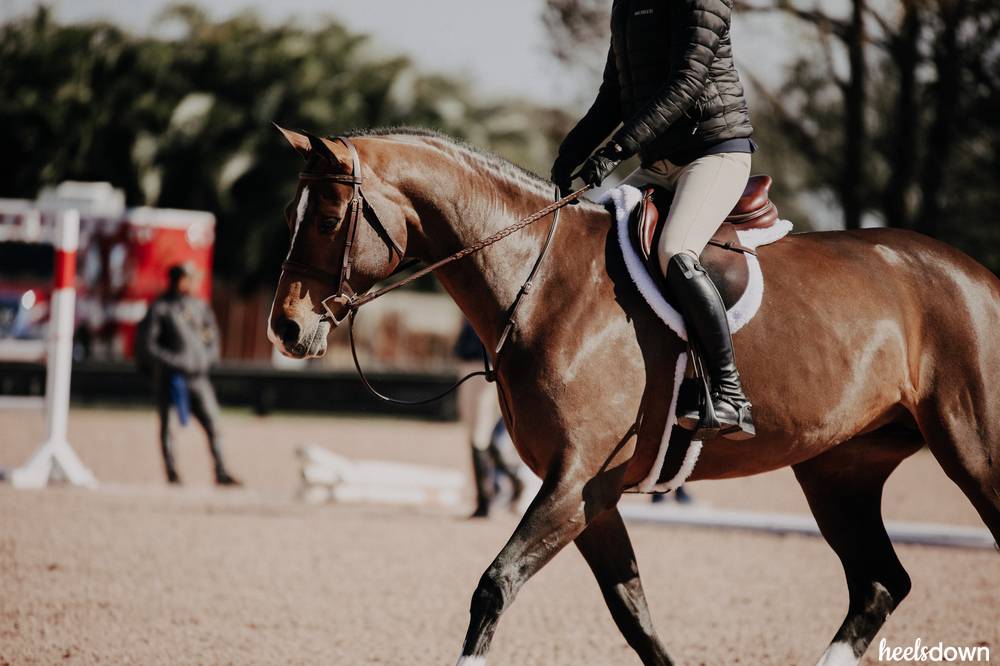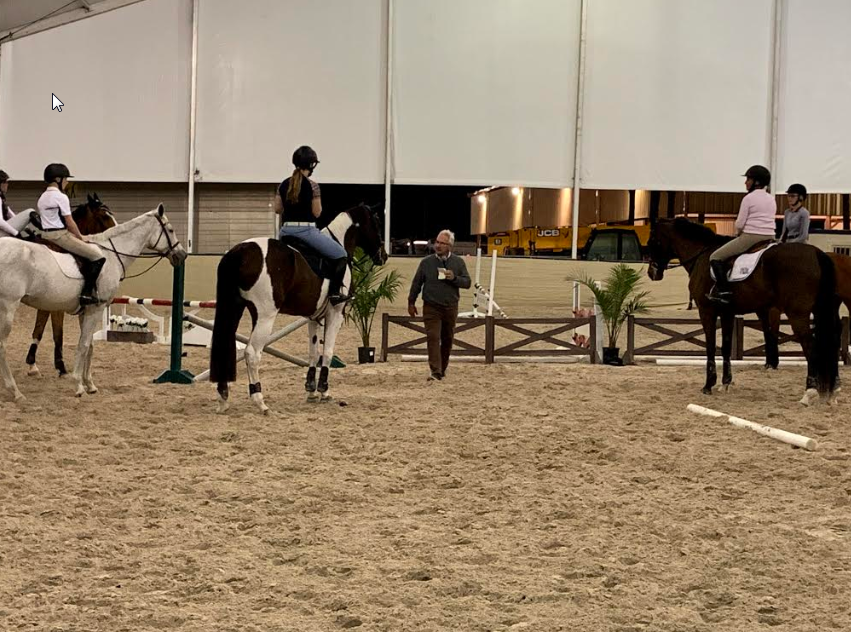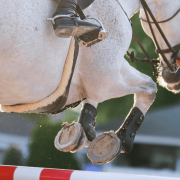Clinic Recap: Frank Madden And Funnel Cake?

By Cathy Sobke
It is a rare event to get deep-fried Oreos, live calf births, and one of the country’s top equitation trainers at one place. So of course, I had to attend.
When I found out about the Frank Madden event in January, I jumped (pun intended) at the idea of getting an evening of training with one of the best in the business, a man who always has at least one student riding in the equitation finals and has taught a laundry list of some of the best young professional riders our sport has seen.
The clinic was being held at the South Florida Fair, the same place that, for two weeks each year, turns a few dozen acres in central Palm Beach County into a hectic spectacle that is somewhere between your traditional county fair, where 4-H kids show off their best livestock, and a mini-Vegas with a blinding array of lights, fried food of all varieties, most on a stick, and an array of traditional fair amusement rides.
Where better to take my mare for some pre-show schooling? I mean, sure, she’s spooky, the kind of spooky where she has tried to bolt from her own fart. But, if she could deal with the hustle and bustle of the fair, then when I competed her in a jumper show the following weekend, she probably would be able to deal with the one lone food truck next to the show ring.
So, we pulled up and unloaded under the equestrian pavilion, a white tent next to the Mooternity tent, where baby calves were being born every few hours (slow clap is deserved for whoever came up with that name). I tacked my mare up in a stall next to the arena while I simultaneously kept an ear open for signs of the previous session wrapping up.
“What makes great riders is not what they do when things are going well, but rather how they respond when not producing desired results.”
Just as I was about to bridle her and head in, the clinic coordinator poked her head down the aisle and advised us riders in the 3-foot section that we may want to wait a few minutes and let the parade pass. Parade? Oh holy bleep. What on earth would I do when she heard a parade pass by, blasting music and all the other antics that would surely send her launching higher than the ferris wheel? I stood in front of her stall as the parade got closer while she happily munched her hay.
When we finally got underway, my second greatest fear was embarrassing myself in front of Frank Madden. As most adult ammies can attest, it is always stressful riding in front of a well-respected trainer for the first time. The ring itself was much smaller than I was accustomed and was full of jumps set at almost every angle. It actually reminded me of the indoor arenas I was familiar with seeing in the Northeast where I grew up. Here in Palm Beach County, and particularly Wellington, most facilities have arenas that could easily swallow two dressage rings.
Once we finally got underway, the clinic went great. Frank ran a tight ship, especially tight given the size of the arena and all six riders. After an hour-and-a-half under Frank’s instruction, my tired little ammie brain was able to walk away with the following points:
Make a Responsive Horse
The warm-up started at the walk with us working on leg yield, then shoulder-in and haunches-in. My mare happened to get a beautiful haunches-in down the far side right in front of Frank, although in reality it was just a spook at some poles sitting along the wall, but at least we looked the part, right? Shortly after, we started working at the trot, moving into an extended trot on the two opposite sides with a more collected trot on the other two.
That exercise was followed by the leg yield at the sitting trot on the one side, where we were supposed to move our horses from the inside of one jump and working toward the rail. The last leg yield to the rail was used to set up the canter. Once in the canter, he wanted us to get into a half-seat and then back down and ask our horses to listen to our seat with their spine.

Ease between the positions was highlighted, as I was corrected when I abruptly moved into my half-seat and Frank instructed to make the transition more gradual. Madden had us move forward and collected, then laterally, and then forward and collected again. The whole purpose was to get our horses listening to us and responding to our aids, which then made for disciplined horses over fences.
Create the Environment
The jumping exercise started as four jumps, with two set perpendicular to the other two. After performing the first exercise, he added another eight or so jumps to the exercise, with only two of those jumps set on a line of three strides. All the jumps were low, maybe 2’6”, and it kept us in a constant pattern of jump, rollback, jump, turn, almost in a clover-leaf pattern. The pattern resulted in a very constant rhythm of jump, turn, balance, approach the next jump without a lot of strides in between.
Frank did not make many comments as to position. Instead, he focused on a consistent pace, and commenting when my horse dropped behind the rhythm on the approach. The constant turning was a deterrent to any horse which may have thought about speeding up on the back side, since it was not long before another approach was imminent.
I appreciated this thoughtful approach to a clinic, since Frank’s pattern could be recreated anywhere and our improvement was not dependent on his constant feedback. The idea was simple: create obstacles where your horse is constantly working and listening, and becoming more consistent, and becoming more responsive.
Do Something Different
One of my favorite sayings is something along the lines of: “The definition of insanity is doing the same thing repeatedly and expecting different results.” Well, it works for horses as much as it does in a science lab. When one of the other riders attempted a leg yield at the trot for two passes without success, the third attempt yielded results simply because she tried something different. Frank took the time to point out that what makes great riders is not what they do when things are going well, but rather how they respond when not producing desired results. The mark of a great rider, he said, is doing something different.
Similarly, taking a clinic within earshot of rides, lights, and the general public on my stupidly spooky mare was supposed to be a recipe for disaster. However, she pleasantly surprised me and showed me should handle more than I credited.
Normally, if I knew my mare had a “spooky spot,” I would try to drill her in that location, focusing her on work near that problem spot until we had gotten to some point of success. If I had tried to get her into the show ring and force her to tolerate the one, solitary food truck, I probably would have created a more tense and resistant horse, which would have manifested in bigger issues on course. By throwing her into the Mecca of fried food trucks, she did not even bat an eye when we showed the following weekend.
Not only did I walk away with a few very valuable nuggets for our continued training, it was a ton of fun riding somewhere completely different and unexpected.


